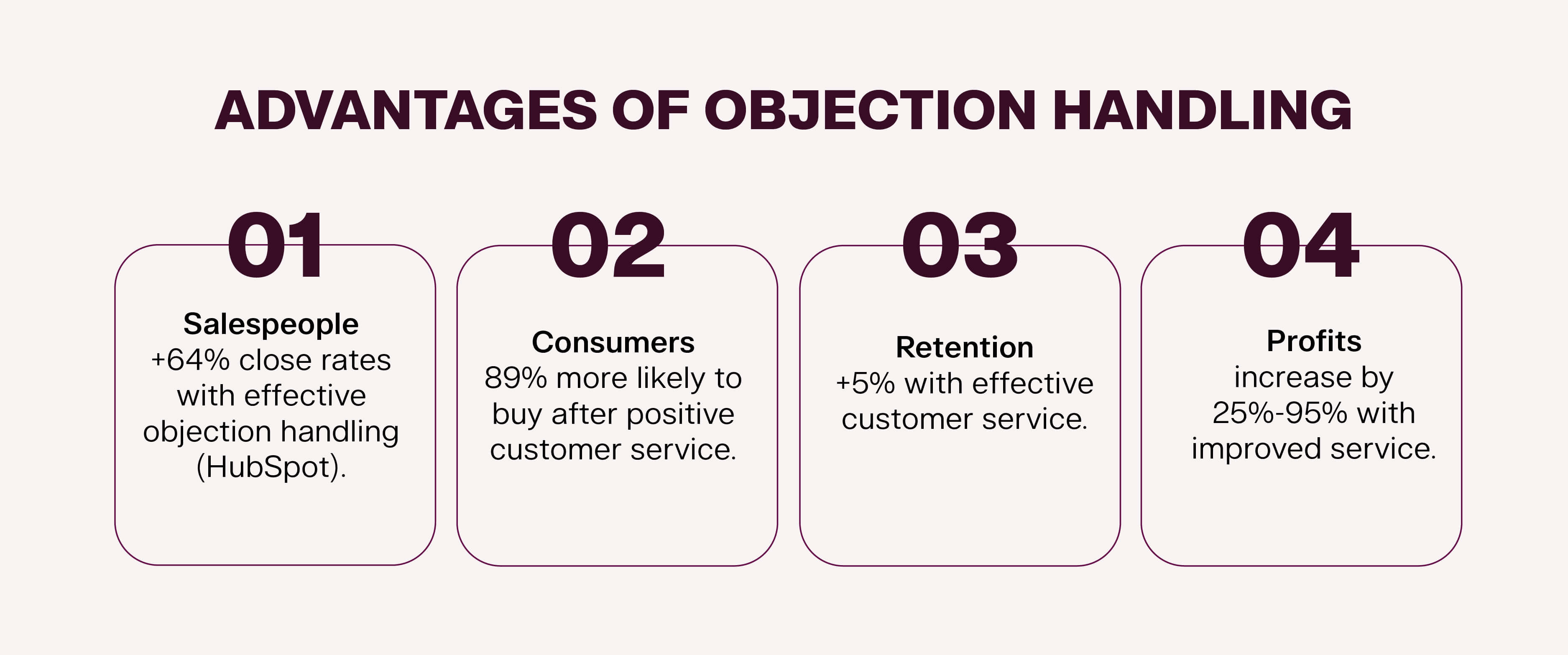
Objection Handling Mastery: Turn 'No' into 'Yes' with Every Call!
When on a prospecting call, often the prospect leans back, sighs, and utters the dreaded word: "No." It happens to the best of us. But what separates top sales performers from the rest? You can master objections and turn them into opportunities.
Understand this: In sales, objections are not roadblocks but stepping stones toward closing deals. Thus, you must understand how to navigate objections that can significantly impact sales success.
And this guide is here to help you do that effortlessly. It covers everything about handling sales calls' objections, from its benefits to precise strategies.
Benefits of Mastering Objections
First off, let us explore what you can benefit from handling prospects' objections like a pro:

1. Increased Close Rates
According to a study by HubSpot, salespeople who effectively handle objections experience a 64% increase in close rates. Thus, they have the upper hand over those who struggle with objections. By doing the same, you can move prospects closer to a buying decision by effectively handling objections.
2. Stronger Client Relationships
After experiencing positive customer service, 89% of consumers are inclined to make additional purchases. Addressing objections demonstrates empathy and understanding and builds client trust and rapport.
3. Enhanced Confidence and Communication Skills
Mastering objections equips you with the confidence to handle any situation, fostering professional growth. It can also increase your customer retention rates by 5% and your profits between 25% and 95%.
Now that you know the benefits, you are ready to learn how to win your prospect's purchase decision. To do this, you must first explore why a B2B prospect can dismiss any deal.
Understanding the "Why" Behind the "No"
You must understand the psychology behind objections during sales calls. It can significantly improve your ability to address and overcome them effectively. While objections often manifest as surface-level concerns such as:
- Fear of change
- Budget constraints
- Perceived lack of value
- they often stem from deeper psychological factors. Here are some common reasons clients might object during sales calls:
1. Fear of Change
Change can be intimidating for many B2B prospects. It disrupts familiar routines and introduces uncertainty. Clients may fear that your product or service will require them to adapt to new processes or technologies, leading to resistance.
Fear of change often stems from a sense of loss of control or comfort. People naturally gravitate toward stability and predictability.
Thus, acknowledge these concerns by emphasizing the positive outcomes and support you'll provide during the transition.
2. Budget Constraints
Financial considerations are a frequent objection in sales. Clients may perceive your offering as too expensive or worry about allocating resources away from other priorities.
Budget objections often reflect concerns about value and return on investment (ROI). Clients want reassurance that your solution will deliver sufficient benefits to justify the cost.
Thus, you must address this by highlighting the long-term value and potential cost savings your product or service offers.
3. Lack of Perceived Value
If clients don't see the relevance or benefits of your offering, they're unlikely to make a purchase. This objection often arises when you fail to effectively communicate how your product or service solves its specific pain points.
Humans are wired to seek solutions to their problems. A lack of perceived value indicates a disconnect between what you're offering and what the client truly needs.
Therefore, dive deeper into their challenges and demonstrate how your solution directly addresses them.
4. Trust Issues
Trust is fundamental in any business relationship. If clients doubt your credibility, reliability, or intentions, they'll hesitate to commit. Trust objections can stem from:
- Past negative experiences
- Skepticism about your claims
- Uncertainty about your integrity
Thus, you must build trust by providing social proof, such as testimonials or case studies. You can also establish rapport through active listening and genuine empathy.
5. Decision-Making Paralysis
Some clients struggle with indecision because they fear making the wrong choice or missing out on better alternatives.
Decision-making paralysis often results from cognitive or information overload. Thus, simplify the process by offering clear guidance, concisely presenting options, and addressing any lingering doubts or uncertainties.
To tackle these challenges, you need a proper framework to handle objections. Let's explore that in detail below.
Building Your Objection Handling Arsenal
You must equip yourself to address client concerns effectively. It helps you ultimately close deals with confidence and finesse. To do so,
- Categorize common objections into critical themes
- Then, develop a framework to address each category
It will provide a structured approach to objection handling.
Here are sample objections and responses for your reference:
| Objection | Example | Focus of the Response |
| Cost | "Your solution is too expensive for our budget." |
|
| Value | "We're not convinced of the value your solution brings." |
|
| Need | "We don't see the immediate need for your solution." |
|
| Authority | "We're not sure if your company is experienced enough." |
|
| Timing | "We're not ready to make a decision yet." |
|
Mastering the Art of Response
Is there any formula for crafting effective responses? Most likely, yes!
It revolves around showing your consistent effort to solve whichever objection your target prospect has.
Let's see a step-by-step approach to creating such responses:
Step 1: Acknowledge and Validate
70% of customers' journeys hinge on their perception of being treated. Therefore, actively addressing your customer's concern is more than just a courteous gesture. It's a strategic move that can significantly impact your sales process.
You show empathy and understanding by acknowledging your potential customer's problem or objection. Hence, it can build trust and rapport about your brand in their mind.
For example, let's imagine that your target project has budget constraints.
So, how can you handle it smoothly?
The first step will be to consider and validate their concern with an empathic response:
"I completely understand your concerns about budget limitations. Ensuring that any investment aligns with your financial goals and resources."
Step 2: Refocus on Benefits
Remember that empathy in your initial response may not be sufficient for prospects.
So, the next step is to refocus the conversation on the benefits of your offered product or service.
By reiterating the benefits and value proposition of the solution, you give prospects a reason to keep the interaction going.
So, continuing with the concern about budget constraints, you must highlight specific features that directly address your prospect's pain points. Refocus your conversation on the benefits; you can reaffirm the solution's value and help the customer see past their initial objections by responding:
"Despite budget constraints, our solution offers substantial long-term benefits. Prioritizing efficiency and cost-effectiveness ensures a strong return on investment, ultimately helping you achieve your business objectives."
Step 3: Present Solutions
Don't end your approach after highlighting the benefits!
Your next step is to offer tailored solutions to overcome objections. You must present yourself as a thought leader with the expertise to address prospects' concerns effectively.
In fact, tailored sales approaches cause a 20% increase in customer satisfaction.
As our hypothetical prospect has tight budget issues, show your commitment to finding a suitable resolution in your response:
"To address your budget concerns, we can explore flexible pricing options tailored to your financial needs. Additionally, we offer financing arrangements or phased implementation to ease the financial burden and ensure our solution remains accessible."
Step 4: Ensure Confirmation and Proceed to Next Steps
Finally, toward the end of your sales call, you must recap key points and propose clear next steps. So, summarize the discussion and outline the next steps in your response:
"To recap, we've discussed your budget concerns, highlighted the significant benefits of our solution, and presented tailored options to accommodate your financial constraints. Shall we proceed with a detailed demo to further explore how our solution can meet your needs?"
It helps your prospect to feel more informed and empowered to move forward.
To further enhance these responses and boost their impact, use the following techniques during sales calls:
Building Confidence and Adaptability: Go Beyond Scripts
Besides a fantastic sales call script, you must know communication techniques that make your call even more effective:
.jpg?width=1000&height=504&name=Objection-Handling-Mastery-02%20(1).jpg)
1. Active Listening
You must understand your target client's perspective to address objections effectively. Practice active listening to truly empathize with your target client's concerns and tailor your responses accordingly. It involves:
- Listening to the prospect's words
- Paying attention to their tone, body language, and underlying motivations
- Paraphrasing or summarizing the customer's concerns to ensure they understand them correctly
Doing so makes it easier to address objections and move the conversation forward.
2. Strategic Silence
The strategic use of silence can be a powerful tool in objection handling. Silence allows your prospect to elaborate on their concerns and provide valuable insights into their objections. You can gather more information and tailor your responses more effectively by giving them space to express themselves fully.
For example, if a customer raises an objection but seems hesitant to elaborate, you might briefly acknowledge the objection and then remain silent. It allows the prospect to fill the silence with additional information. It can help you better understand and address the prospect's concerns more comprehensively.
3. Authenticity Maintenance
It's crucial to establish trust and credibility with prospects. Keep your conversation genuine to foster a sense of connection and to better understand your client's needs and concerns.
Robotic scripts can alienate prospects and hinder effective communication. Instead, you must:
- Focus on using authentic dialogue
- Move beyond rigid scripts and engage in natural, spontaneous conversations
4. Confident Approach
Remember, confidence is critical in sales; relying solely on scripts can undermine your confidence levels.
Ensure you feel confident in their knowledge, expertise, and ability to authenticate conversations. You can exude credibility and inspire trust in prospects. Building confidence involves:
- Ongoing training and practice
- Reinforcement of essential sales skills
-empowering sales professionals to adapt and respond effectively to various situations.
5. Versatility in Script
Every prospect is unique, with individual preferences, concerns, and objections. You must be adaptable and able to pivot your approach based on the prospect's responses and cues.
Ensure to become more agile and responsive. Stay better equipped to address objections, overcome challenges, and successfully close deals.
Continually gather feedback from customer interactions, analyze objection patterns, and refine their responses accordingly.
6. Question Anticipation and Preparation
Train your sales team to anticipate potential objections. Proactively identify and address common objections so your sales teams can better navigate conversations. Thus, it increases the chances of success.
It involves crafting compelling arguments, providing relevant information or evidence, and highlighting the value proposition of the product or service. You can confidently address objections during conversations and alleviate prospects' doubts or hesitations by preparing early responses.
7. Role-Play and Training
Through simulated sales scenarios, your team members can practice:
- Responding to objections in a controlled environment
- Receiving feedback from peers or mentors and refining their approach
It helps build confidence, sharpen communication skills, and instill a proactive mindset when handling objections during real-world interactions.
Conclusion
You learned how your prospects' objections can become stepping stones for successful deals. Ensure you handle their concerns with sensitivity and strategically.
Follow our guidance to transform such setbacks into future business opportunities.
This is where Revnew can assist you with the skills to navigate cold sales calls seamlessly. We have a team of experts who are well-equipped in this prospecting area. Contact us today to elevate your sales game and close deals consistently with confidence and expertise.




